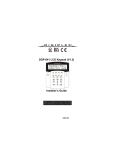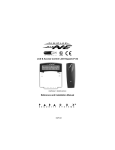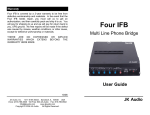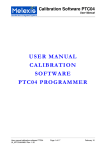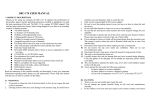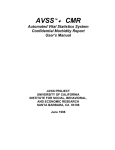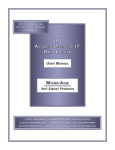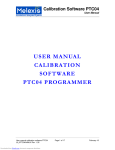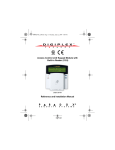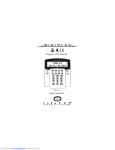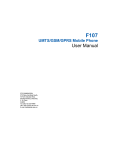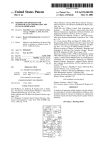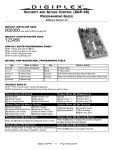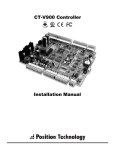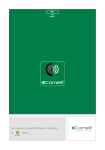Download DGP-641 LCD Keypad - Hobbielektronika.hu
Transcript
DGP-641 LCD Keypad (V1.3) DGP-641ACC Access Control LCD Keypad (V1.1) Reference and Installation Manual TABLE OF CONTENTS 1.0 Introduction ....................................................... 4 1.1 S PECIFICATIONS ........................................................ 5 2.0 Installation......................................................... 6 2.1 C ONNECTING THE K EYPAD ........................................ 6 2.2 C ONNECTING K EYPAD ZONES .................................... 6 2.3 P ROGRAMMABLE OUTPUT ......................................... 7 3.0 Programming ................................................. 11 3.1 E NTER M ODULE P ROGRAMMING M ODE .................... 11 3.2 P ROGRAMMING MET HODS ....................................... 12 3.2.1 Feature Select Programming ................................... 12 3.2.2 Decimal Programming .............................................. 12 3.3 M ODULE BROADCAST ............................................. 12 4.0 System Options .............................................. 14 4.1 P ARTITION A SSIGNMENT .......................................... 4.2 D ISPL AY CODE ENTRY ............................................ 4.3 D ISPL AY EXIT DELAY T IMER .................................... 4.4 D ISPL AY ENTRY D ELAY TIMER ................................ 4.5 C ONFIDENTIAL M ODE .............................................. 4.6 M UTING .................................................................. 4.7 B EEP ON E XIT D ELAY .............................................. 4.8 C HIME ON ZONE CLOSURE ...................................... 14 14 14 15 15 16 17 17 Digiplex LCD Keypad 1n 4.9 B EEP ON TROUBL E .................................................. 17 4.10 KEYPAD T AMPER ENABLE ..................................... 18 5.0 Features For DGP-641 Only........................... 19 5.1 C ONF IDENT IAL MODE T IMER .................................... 5.2 PGM S TATE ............................................................ 5.3 PGM A CTIVATION EVENT ........................................ 5.4 PGM D EACT IVATION EVENT .................................... 5.5 PGM T IMED M ODE .................................................. 5.6 PGM T IMER ............................................................ 5.7 PGM B ASE TIME ..................................................... 5.8 PGM O VERRIDE ...................................................... 19 19 20 20 21 21 21 22 6.0 Features For DGP-641ACC Only ................... 23 6.1 B US VOLTMETER ..................................................... 23 6.2 A SSIGNING D OORS T O PARTITIONS .......................... 23 6.3 R EADER’ S OPT IONS ................................................. 24 6.3.1 Reader’s LED To Follow Partition’s Status ............ 24 6.3.2 Reader’s Beep To Follow Partition's Status ........... 24 6.3.3 Reader's LED Options Upon Access Granted........ 25 6.4 D OOR L OCK O PTIONS .............................................. 25 6.4.1 6.4.2 6.4.3 6.4.4 6.4.5 6.4.6 Unlock on REX (Request For Exit) .......................... 25 Door Unlocked Period .............................................. 25 Door Unlocked Period Extension ............................ 26 Relock Interval........................................................... 26 Door Unlocked Schedule.......................................... 26 Card Activates Door Unlocked Schedule ............... 27 2 Installer’s Guide 6.5 D OOR LEFT OPEN O PTIONS .................................... 28 6.5.1 Door Left Open Access Alarm ................................. 28 6.5.2 Door Left Open Interval Before Access Alarm ....... 29 6.5.3 Door Left Open Pre-Alarm ........................................ 29 6.5.4 Door Left Open Pre-Alarm Timer ............................. 29 6.5.5 Door Left Open Alarm Feedback ............................. 30 6.5.6 Beep Timer For Door Left Open Alarm ................... 31 6.6 D OOR FORCED O PEN OPT IONS ............................... 31 6.6.1 Door Forced Open Access Alarm ............................ 31 6.6.2 Door Forced Open Feedback ................................... 32 6.6.3 Beep Timer For Door Forced Open Alarm .............. 32 7.0 Message Programming .................................. 33 8.0 Glossary .......................................................... 36 Digiplex LCD Keypad 3n 1.0 INTRODUCTION Thank you for choosing Paradox® Security Systems. The Digiplex™ Security System is an advanced technology security system that will provide reliable security protection and powerful features that are easy to use. The elegant and user-friendly Digiplex™ LCD Keypad will allow easy access to the security system's functions and information at the touch of a button. Since all programming is accomplished through the keypad, please read this manual carefully. As well as normal security system functions, the Digiplex Access Control Keypad (DGP-641ACC) can also be used for access control. Access Control is designed to monitor and control the access for up to 32 designated doors without the need of an additional control panel. The events that occur on an Access Control door can be logged in the control panel’s Event Buffer, but can only be viewed through an Access Control Keypad. Each door to become an Access Control door requires an Access Control Keypad (DGP-641ACC), a reader (suggestion: Posiprox CR-R880), a REX device (suggestion: Paradoor 460), a door contact, and a locking device. If desired, door contacts can also be assigned to zones in the control panel to link the doors to the Digiplex Alarm system. This will allow you to use the same door for the Access Control system and the alarm system. Only two of the Access Control features require that the Access Control door's door contact be assigned to a zone: Burglar Alarm on Forced Door in section [537] option [5] and Access to Armed Access Control Doors in sections [802] to [896], fourth screen, option [8]. 4 Installer’s Guide 1.1 S PECIFICATIONS Power input: PGM current limit: Number of inputs: 9-16 VDC, 80mA maximum 50 mA 1 (DGP-641) 2 (DGP-641ACC) Power indication: Yellow LED on Locate indication: Green and yellow LEDs flash simultaneously Bus fault indication: Red and yellow LEDs flash alternately Tamper Switch: Yes (also used to deactivate locate) LCD: Super Twisted Nematic display (STN), wide viewing angle, 2 lines of 16 characters, backlight and contrast adjustable Compatibility: DGP-641: Any Digiplex Control Panel DGP-641ACC: DGP-48 Control Panel for Access Control V2.20ACC and higher Digiplex LCD Keypad 5n 2.0 INSTALLATION 2.1 C ONNECTING THE KEYPAD The Digiplex™ LCD keypads (DGP-641 and DGP-641ACC) are connected to the control panel's bus in a star and/or daisy chain configuration. This 4-wire communication bus provides power and two-way communication between the control panel and all modules connected to it. Connect the four terminals labeled red, black, green and yellow of each keypad to the corresponding terminals on the control panel (refer to Figure 1 on page8). Refer to the Digiplex Control Panel's Reference & Installation Manual for the maximum allowable installation distance from the control panel. See Figure 4 on page 10 for connection drawings for the REX device, reader, locking device and door contact to the desired DGP-641ACC keypad. A typical installation is shown in Figure 2 on page 9 . The door contact follows the control panel’s EOL definition. When EOL is enabled and the door contact is not used, place a 1k Ω resistor across the keypad’s Z1 and BLK input terminals. If EOL is not enabled, use a jumper. If the REX device is not used, place a jumper across the keypad’s Z2 and BLK input terminals. 2.2 C ONNECTING KEYPAD Z ONES Each keypad has one traditional hardwired input terminal, allowing you to connect one detector or door contact directly to 6 Installer’s Guide the keypad. For example, a door contact located at the entry point of an establishment can be wired directly to the input terminal of the entry point keypad instead of wiring the door contact all the way to the control panel. Connect the device to the keypad's input terminal as shown in Figure 1 on page8. In order to communicate its status to the control panel, devices connected to the keypad's input terminal must be assigned to a zone in the control panel and the zone's parameters must be defined. For more information on zone assignment, please refer to the Digiplex Control Panel's Reference & Installation Manual. Please note that even with the ATZ (zone doubling) feature enabled, the keypad supports only one detection device. 2.3 P ROGRAMMABLE OUTPUT Each keypad has one on-board PGM. A PGM is a programmable output that toggles to its opposite state (i.e. a normally open PGM will close) when a specific event has occurred in the system (see section 5.0 on page 19). Upon activation, the PGM can provide 50mA to any device connected to it. If the current drawn is to exceed the current limit, a relay should be connected to the PGM as shown in Figure 1. With the DGP-641ACC keypad, the PGM is reserved for the door lock (refer to Figure 4 on page 10). Digiplex LCD Keypad 7n Figure 1: Connecting the Keypad and Keypad Zone 8 Installer’s Guide Figure 2: Typical Access Control Installation (DGP-641ACC) Figure 3: Access Control Overview (DGP-641ACC Only) Digiplex LCD Keypad 9n Figure 4: Access Control Connections (DGP-641ACC Only) 10 Installer’s Guide 3.0 PROGRAMMING Programming the DGP-641 or DGP-641ACC LCD keypads is simple. Enter the “Module Programming Mode”, enter the desired section followed by the required data. When programming the keypad, use the keypad’s Programming Guide to keep track of which sections were programmed and how. We strongly recommend you read this entire manual before you begin programming. The LCD keypad can also be programmed using the WinLoad Security System Management Software. For more information, refer to the WinLoad instructions or visit our web site at www.paradox.ca. 3.1 E NTER MODULE P ROGRAMMING M ODE The keypad, like all other modules in the Digiplex system, is programmed through the control panel. To do so, you must first enter the “Module Programming Mode”: Step 1: From Normal Mode press and hold the [0] key. Step 2: Enter the [INSTALLER CODE] (by default 000000) Step 3: Enter section [953] Step 4: Enter the keypad’s 8-digit [SERIAL NUMBER ]. Step 5: Enter the 3-digit [SECTION] you want to program. Step 6: Enter the required [DATA]. The control panel will then redirect all programming to the selected keypad. Every time the [CLEAR] key is pressed it will revert to the preceding step, unless entering in data in which case it will erase the current data entry. Please note that the Digiplex LCD Keypad 11n serial number is located on the keypad's PC board or enter section [000] in Step 3 to view the keypad’s serial number. 3.2 P ROGRAMMING METHODS 3.2.1 Feature Select Programming Program sections [001] to [005] by enabling or disabling options. Within the sections, numbers from [1] to [8] represent a specific keypad option. Press the key corresponding to the desired option and the digit will appear in the display. This means the option is enabled. Press the key again to remove the digit from the display thereby disabling the option. Press [ENTER] when options are set. 3.2.2 Decimal Programming Sections [006] and [007] are programmed using “Decimal Programming”. In this method, any digit from 000 to 255 can be entered. 3.3 M ODULE BROADCAST The Digiplex Control Panel’s Module Broadcast feature can be used to copy the contents of one keypad to one or many other keypads. Step 1: Step 2: Step 3: Step 4: From Normal Mode press and hold the [0] key. Enter [ INSTALLER CODE]. Enter section [954]. Enter the [ SERIAL #] of the source keypad. The source is the programmed keypad whose data you want to copy to other keypads. Step 5: Enter the [ SERIAL #] of the destination keypads. The destination is the keypad(s) you want to program with the 12 Installer’s Guide source’s data. If you want to program more than one keypad with the source’s data, enter the serial numbers of the keypads one at a time. Step 6: Once you have entered the serial numbers of the keypads you want to program, press the [ ACC ] key. Digiplex LCD Keypad 13n 4.0 SYSTEM OPTIONS 4.1 P ARTITION ASSIGNMENT Section 001: Options [1] to [4] Each keypad in the Digiplex system can be assigned to one or more partitions. In section [001], options [1] to [4] represent partitions 1 through 4 respectively. To assign the keypad to a partition, simply enable the option that corresponds to the desired partition. Therefore, the keypad would be assigned to partitions 1 and 4 only. (By default, partition 1 to partition 4 are enabled.) 4.2 D ISPLAY C ODE E NTRY Section 002: Option [1] The digits of the User Access Codes can be displayed on the LCD screen when they are entered. Option [1] OFF= Digits are replaced by a *. (default) Option [1] ON = Access Code digits will be displayed. 4.3 D ISPLAY E XIT DELAY T IMER Section 002: Option [2] Based on the user's needs, an Exit Delay Timer will be programmed to provide the user time to exit the partition before the system is armed. The Exit Delay Timer's countdown can be displayed on the LCD screen. 14 Installer’s Guide Option [2] OFF= Will not display Exit Delay timer (default) Option [2] ON = LCD screen will display Exit Delay timer 4.4 DISPLAY E NTRY DELAY T IMER Section 002: Option [3] Based on the user's needs, an Entry Delay Timer will be programmed to provide the user time to enter their User Access Code before the alarm is triggered. The Entry Delay Timer's countdown can be displayed on the LCD screen. Option [3] OFF= Will not display the Entry Delay Timer (default) Option [3] ON = LCD screen will display Entry Delay Timer 4.5 CONFIDENTIAL MODE Section 002: Option [4] and [5] If the Confidential Mode is enabled and no actions are performed on the keypad for a period of time, the LCD screen will appear as shown in Figure 5 (page 16) and the “AC” and “STATUS” LED will be off until either a button is pressed or an access code is entered. For the DGP-641 keypad, the period of time in which no action is performed is defined by the Confidential Mode Timer (005-255 seconds; refer to section 5.1 on page 19). For the DGP-641ACC keypad, the period of time in which no action is performed is set at 2 minutes. Confidential Mode is activated by enabling option [4]. Option [5] regulates whether the LCD screen will be activated at the touch of a button or only when an access code is entered. Once the LCD screen is activated (by code or button), Normal Mode will appear and display the date and time as shown in Figure 5 on page 16. The status of the areas, the open zones for Digiplex LCD Keypad 15n every area the keypad is assigned, the Alarm Memory Display if necessary, and the Trouble Display if necessary (see Digiplex User Manual) will also scroll on the LCD screen. Section [002]: Option [4] OFF= Normal Mode (default) Option [4] ON = Confidential Mode Option [5] OFF= LCD screen activated by entering an access code (default) Option [5] ON = LCD screen activated by pressing a button Figure 5: LCD Screen 4.6 M UTING Section 003: Option [1] The keypad can be programmed not to emit audible sounds, including Chimed zones. During Muting, the keypad will only emit the Confirmation Beep, Rejection Beep, and beep when a button is pressed. Option [1] OFF= Audible sounds (default) Option [1] ON = Mute 16 Installer’s Guide 4.7 BEEP ON E XIT DELAY Section 003: Option [2] The keypad can beep once every second during the Exit Delay Timer. During the final 10 seconds, it will beep more rapidly to provide a final warning before the area is armed. Option [2] OFF= Exit Delay beep disabled Option [2] ON = Exit Delay beep enabled (default) 4.8 CHIME ON Z ONE CLOSURE Section 003: Option [4] During the Chime Zone Time Period that the user sets, the keypad can emit an intermittent beep whenever a zone with the Chime feature enabled closes (see Digiplex User Manual for details on Chime Zones). If the user does not set the Chime Zone Time Period and this option is enabled, the Chime Zones will always beep upon closure. Option [4] OFF= Chime on Zone Closure disabled (default) Option [4] ON = Chime on Zone Closure enabled 4.9 BEEP ON TROUBLE Section 004: Options [1] to [4] Potential troubles have been sorted into groups. With these options enabled, the keypad will emit an intermittent beep tone whenever a trouble condition from the Trouble Groups occurs in the system. The intermittent beep will remain activated until the user enters the Trouble Display or if the trouble is resolved. For a list of the troubles, Digiplex LCD Keypad 17n see the Digiplex Control Panel’s Reference and Installation Manual. The intermittent beep will be re-initialized whenever the trouble condition re-occurs. Option [1] OFF= Beep disabled: System Troubles and Clock Loss (default) Option [1] ON = Beep enabled: System Troubles and Clock Loss Option [2] OFF= Beep disabled: Communicator Troubles (default) Option [2] ON = Beep enabled: Communicator Troubles Option [3] OFF= Beep disabled: Module and Bus Troubles (default) Option [3] ON = Beep enabled: Module and Bus Troubles Option [4] OFF= Beep disabled: all Zone Troubles (default) Option [4] ON = Beep enabled: all Zone Troubles 4.10 KEYPAD T AMPER E NABLE Section 005: Option [5] When Tamper is enabled and the keypad's on-board tamper switch is triggered, the keypad will send a Tamper report to the control panel via the communication bus. Option [5] OFF= Keypad's Tamper is disabled (default) Option [5] ON = Keypad's Tamper is enabled 18 Installer’s Guide 5.0 FEATURES FOR DGP-641 ONLY 5.1 CONFIDENTIAL MODE TIMER Section 006 (Default: 120 seconds) Section [006] determines the amount of time without action before the keypad enters Confidential Mode. For more information on Confidential Mode, refer to “Confidential Mode” on page15. The Confidential Mode Timer can be set from 005 seconds to 255 seconds. 5.2 PGM STATE Section 005: Option [1] The keypad's on-board PGM can be set as normally open or normally closed. When an open PGM is activated, it will close the circuit from ground and enable any devices connected to it. When a closed PGM is activated, it will open the circuit and disable any devices connected to it. When the PGM Activation Event occurs (see section 5.3), the PGM will switch to its opposite state (i.e. open to closed or closed to open). Option [1] OFF= PGM is Normally Open (default) Option [1] ON = PGM is Normally Closed The PGM can provide 50mA to any device connected to it. Digiplex LCD Keypad 19n 5.3 PGM A CTIVATION E VENT Section 008 The PGM Activation Event determines which event(s) will activate the keypad's on-board PGM. For details on the available activation events, refer to the PGM Programming Table in the Digiplex Programming Guide. 6) In section [008], key in the first digit where each digit from 8 to F represents an event group (0 = PGM Disabled). The first digit cannot be a value from 1 to 7. 7) Then enter the second digit, which can be any digit from 0 to F depending on the first digit chosen. 8) After entering the second digit, use Feature Select Programming (page 12) to enable/disable options [1] to [8]. Each option represents a specific event as detailed in the PGM Programming Table on the Digiplex Programming Guide. These keys represent the hexadecimal values from A to F: [STAY] =A [ARM] =C [BYP] = E [FORCE] = B [DISARM] = D [MEM] = F 5.4 PGM D EACTIVATION E VENT Section 009 Once the PGM Activation Event, see section 5.3 on page21, has occurred, the keypad's on-board PGM will return to its normal state (deactivate) when the event programmed in section [009] occurs unless the keypad is in PGM Timed Mode, see section 5.5 on page 21. The PGM Deactivation Event is programmed in 20 Installer’s Guide the same manner as the PGM Activation Event. 5.5 PGM TIMED MODE Section 005: Option [2] If the keypad is in PGM Timed Mode, the keypad's on-board PGM will be deactivated according to the PGM Timer (see section 5.6 below) instead of the PGM Deactivation Event. Option [2] OFF= Deactivates on PGM Deactivation Event (default) Option [2] ON = PGM will deactivate according to the PGM Timer 5.6 PGM TIMER Section 007 If the keypad's on-board PGM is in PGM Timed Mode, the value programmed in section [007] represents how long the PGM will remain in its opposite state (see section 5.2 on page 19) after being activated. To program the timer, enter a 3-digit decimal value (000 to 255) in section [007]. The 3-digit value will be multiplied by the PGM Base Time of 1 second or 1 minute (see section 5.7 below). 5.7 PGM BASE T IME Section 005: Option [3] If the keypad's on-board PGM is set in PGM Timed Mode (see section 5.5 above) you must define whether the value programmed in section [007] is in minutes or seconds. Option [3] OFF= PGM Base Time is 1 second (default) Digiplex LCD Keypad 21n Option [3] ON = PGM Base Time is 1 minute 5.8 PGM O VERRIDE Section 005: Option [4] When PGM Override is enabled, the keypad's on-board PGM will ignore PGM Activation Events (section 5.3, page 20), PGM Deactivation Events (section 5.4, page 20), and PGM Timers (section 5.6, page21). It will remain in its normal state until the PGM Override is disabled. This option may be used to test the PGM connections. Option [4] OFF= PGM Override disabled (default) Option [4] ON = PGM Override enabled 22 Installer’s Guide 6.0 FEATURES FOR DGP-641ACC ONLY 6.1 BUS V OLTMETER The Bus Voltmeter provides a real-time display of the voltage so you can verify if the bus is supplying sufficient power at the keypad’s location. The readings will appear on the LCD screen. A reading of 9.2V indicates that the voltage is too low. This may occur when too many modules are connected to the bus, a module is installed too far from the panel or if the system is running on the battery. In some cases adding an external power supply may correct the situation. Step 1: From Normal Mode press and hold the [0] key. Step 2: Enter the [INSTALLER CODE] (by default 000000) Step 3: Press [ACC] The voltage may drop during the control panel battery test. 6.2 ASSIGNING DOORS T O P ARTITIONS Section [001]: Options [5] to [8] Although the keypad can be programmed to display the status of various partitions, the Access Control door can be assigned to one or more partition(s) in the alarm system. This means that the actions performed with the Access Control Card will be directly linked to the partition(s) assigned to that door. For example, the keypad is assigned to all four partitions (see section 4.1 on page14), but the door is assigned to Partition 2. When the user presents the Access Control Card to the door's reader to arm the Digiplex LCD Keypad 23n partition, only Partition 2 will arm. Option [5] ON Option [6] ON Option [7] ON Option [8] ON OFF = = = = = door assigned to Partition 1(default) door assigned to Partition 2 door assigned to Partition 3 door assigned to Partition 4 Access Control Cards will not be able to arm and/or disarm partitions from the door's reader. 6.3 R EADER’S OPTIONS 6.3.1 Reader’s LED To Follow Partition’s Status Section [002]: Option [6] The reader's LED can be programmed to flash according to the partition's status. When this feature is enabled, the reader’s red LED will flash when the partition is arming, in Exit Delay, in Entry Delay, in Burglar Alarm or in Fire Alarm. Option [6] ON = LED follows the door’s partition status. (default) Option [6] OFF= The reader's LED will not flash. 6.3.2 Reader’s Beep To Follow Partition's Status Section [002]: Option [7] This feature will only function when section [002] option [6] is enabled. The reader can be programmed to beep according to its keypad's beep when the partition assigned to the door is arming, in Exit Delay, in Entry Delay, in Burglar Alarm, or in Fire Alarm. Option [7] ON = Beep follows the partition's status. (default) Option [7] OFF= The beep will not follow the partition's status. 24 Installer’s Guide 6.3.3 Reader's LED Options Upon Access Granted Section [005]: Option [7] When the Access Control card is presented to the reader, the reader's LED can be programmed to turn green during the door’s unlocked period (or until the door closes) or extinguish briefly to indicate that the door is unlocked. Option [7] ON = The reader's red LED will turn green (default). Option [7] OFF= The reader's red LED will extinguish briefly. 6.4 DOOR L OCK OPTIONS 6.4.1 Unlock on REX (Request For Exit) Section [005]: Option [8] When the REX device detects movement, it can permit passage with or without turning the door handle. If this option is on, the door is unlocked when the REX device detects movement and users on either side of the door will be able to open the door. If this option is off, the door will unlock once the handle is turned only on the REX device’s side. Option [8] ON = Unlock on REX enabled. Option [8] OFF= Unlock on REX disabled. (default) 6.4.2 Door Unlocked Period Section [006] The Door Unlocked Period is the time the door can remain unlatched after access is granted or after a Request for Exit is received. Enter any value between 001 and 255 to determine the seconds the door can remain unlatched. (default = 5 seconds) Digiplex LCD Keypad 25n 6.4.3 Door Unlocked Period Extension Section [007] The Door Unlocked Period Extension is the amount of time added to the Door Unlocked Period in section [006], which leaves the door unlatched longer. This will allow those with this feature enabled on their User Access Codes extra time to enter, which may be useful for the physically challenged or for seniors. Enter any value between 001 and 255 to determine the number of seconds to be added to the time programmed in section [006]. (default = 15 seconds) 6.4.4 Relock Interval Section [005]: Option [6] The locking device will remain unlatched during the Door Unlocked Period (see section 6.4.2 on page 25), but once the door is opened it can be programmed to latch as soon as the door closes or latch immediately even if the door has not closed. Option [6] ON = Locking device latches when door closes Option [6] OFF= Locking device latches immediately. (default) 6.4.5 Door Unlocked Schedule Section [012] The Door Unlocked Schedule determines the hours, days, and holidays that the door will remain unlocked. Therefore, users will not have to present their Access Control Cards to the reader in order to gain access to an Access Control Door during the Door Unlocked Schedule. The schedule consists of two programmable time periods called “Intervals” that determine the time of day and which days the users will be granted access. When a schedule is 26 Installer’s Guide programmed with “H”, users will have access during the days programmed in the sections [381] to [392]. Program the Start Time and End Time according to the 24-hour clock within the same day. Use Feature Select Programming to set the options representing the Days. Option [1] [2] [3] [4] Day Sunday (S) Monday (M) Tuesday (T) Wednesday (W) Option [5] [6] [7] [8] Day Thursday (T) Friday (F) Saturday (S) Holidays (H) For example, program: • Interval A: Start time 07:00, End time 16:00, Days M, T, W, T, & F • Interval B: Start time 10:00, End time 17:00, Days S, S, & H Then, the door will stay unlocked on Monday, Tuesday, Wednesday, Thursday, and Friday between 7AM and 4PM and on Saturday, Sunday, and Holidays between 10AM and 5PM. Therefore, users will not have to present their Access Control Cards during the Door Unlocked Schedule. 6.4.6 Card Activates Door Unlocked Schedule Section [005]: Option [1] When the Door Unlocked Schedule is programmed and this option is enabled, the door is locked until the first valid Access Control Card is presented. Once the door is unlocked, it will remain unlocked until the end of the schedule. For example: the schedule is 7AM to 5PM Monday to Friday, option [1] is enabled, and a valid Access Control Card is Digiplex LCD Keypad 27n presented to the reader at 8AM on Monday. Although the schedule started at 7AM, the door remained locked from 7AM to 8AM. Once access was granted at 8AM, the door remained unlocked until 5PM. Option [1] ON = Card activates Door Unlocked Schedule Option [1] OFF= The Schedule activates without Card (default) 6.5 D OOR L EFT OPEN O PTIONS 6.5.1 Door Left Open Access Alarm Section [005]: Option [2] When an Access Control door is opened after an Access Granted or a Request for Exit, an Access Alarm can be generated if it not closed within a certain period of time (see section 6.5.2 on page 29). Option [2] ON = Door Left Open Alarm is enabled. (default) Option [2] OFF= Door Left Open Alarm will not be generated. When the Door Left Open Alarm is disabled, the following sections are also disabled: Section [003] Option [3] Door Left Open Pre-alarm Option [5] Door Left Open Alarm (audible/silent) Option [6] Door Left Open Alarm follows (restore/timer) [008] Door Left Open Interval [009] Door Left Open Pre-alarm Timer [010] Beep Timer for Door Left Open Alarm 28 Installer’s Guide 6.5.2 Door Left Open Interval Before Access Alarm Section [008] The Door Left Open Interval is the time that a door can remain open after an Access Granted or a Request for Exit without generating an Access Alarm. Enter any value between 001 and 255 to determine the number of seconds the door may remain open before the Access Alarm is triggered. (default = 60 seconds) 6.5.3 Door Left Open Pre-Alarm Section [003]: Option [3] An Access Control door is programmed with a Door Left Open Interval (see section 6.5.2 above). The Pre-Alarm will cause the reader to beep a certain time before the end of the Door Left Open Interval to alert users that the Access Control door was left open and will generate an Access Alarm if it is not closed. The Pre-Alarm beeps slower than the Door Left Open Alarm (about twice every second). Program the Pre-Alarm timer in section [009]. Option [3] ON = Pre-Alarm is enabled. (default) Option [3] OFF= The Pre-Alarm will not be generated. 6.5.4 Door Left Open Pre-Alarm Timer Section [009] This timer will trigger the Door Left Open Pre-Alarm before the end of the Door Left Open Interval (see section 6.5.3 above). For example, if 60 seconds is programmed in section [008] and 15 seconds is programmed in section [009], then 60 minus 15 is 45. Therefore, the reader will start beeping after the door has been Digiplex LCD Keypad 29n open for 45 seconds. Enter any value between 001 and 255 to determine the seconds before the expiry of the Door Left Open Interval that the reader will beep. (default = 15 seconds) Figure 9: Pre-Alarm example 6.5.5 Door Left Open Alarm Feedback Section [003]: Options [5] and [6] An Access Control door is programmed with a Door Left Open Interval (see section 6.5.2 on page 29). Once this interval has expired, the Door Left Open Alarm can be either audible or silent and will either beep as long as the Access Alarm is occurring or follow the Beep Timer in section [010]. The sound of the Door Left Open Alarm resembles the rapid beep generated during the last ten seconds of the Exit Delay. When the door is closed during an Access Alarm, the Door Left Open Restore event can be logged in the Event Buffer. Option [5] ON = The Door Left Open Alarm is audible. (default) Option [5] OFF= The Door Left Open Alarm is silent. If option [5] is enabled: Option [6] ON = Door Left Open Alarm follows Beep Timer (section [010]) 30 Installer’s Guide Option [6] OFF= beep as long as the Door Left Open Alarm is occurring (default) 6.5.6 Beep Timer For Door Left Open Alarm Section [010] This Beep Timer determines the amount of time the Door Left Open Alarm will beep. Once the Door Left Open Interval (see section 6.5.2 on page 29) has expired, the Door Left Open Alarm (see section 6.5.5 on page 30) will be triggered. Enter any value between 001 and 255 to determine the number of seconds the Access Alarm will beep. (default = 5 seconds) 6.6 DOOR F ORCED OPEN O PTIONS 6.6.1 Door Forced Open Access Alarm Section [005]: Options [3] If an Access Control door is opened without an Access Control Card, a User Access Code or receiving a Request for Exit, an Access Alarm can be generated. A Burglar Alarm can also be generated. When the door is closed during an Access Alarm, the Door Forced Open Restore event can be logged in the Event Buffer. Option [3] ON = Door Forced Open Alarm is enabled. (default) Option [3] OFF= Door Forced Open Alarm is disabled. When the Door Forced Open Alarm is disabled, the following sections are also disabled: Digiplex LCD Keypad 31n Section [003] Option [7] Door Forced Open Alarm (audible/silent) Option [6] Door Forced Open Alarm follows (restore/timer) [011] Beep Timer for Door Forced Open Alarm 6.6.2 Door Forced Open Feedback Section [003]: Options [7] and [8] The Access Alarm can be either audible or silent and will either beep as long as the Access Alarm is occurring or follow the Beep Timer in section [011]. The sound of the Door Forced Open Alarm resembles the rapid beep generated during the last ten seconds of the Exit Delay. Option [7] ON = Door Forced Open Alarm is audible (default) Option [7] OFF= Door Forced Open Alarm is silent If option [7] is enabled: Option [8] ON = Door Forced Open Alarm follows Beep Timer (section [011]) Option [8] OFF= will beep as long as Door Forced Open Alarm is occurring (default) 6.6.3 Beep Timer For Door Forced Open Alarm Section [011] This Beep Timer determines the amount of time the Door Forced Open Alarm (see section 6.6.2 above) will beep. Enter any value between 001 and 255 to determine the number of seconds the Door Forced Open Alarm will beep. (default = 5 seconds) 32 Installer’s Guide 7.0 MESSAGE PROGRAMMING Sections 101 to 249 Each section from [101] to [249] contains one message with a maximum of 16 characters. For more details and to record any changes, use the DGP-641 LCD Programming Guide. Section [101] to [148] = Zone 01 to Zone 48 respectively Section [149] to [244] = Code 01 to Code 96 respectively Section [245] = Paradox Family Section [246] to [249] = First, Second, Third, & Fourth Area respectively After entering the section corresponding to the desired message, the message can be re-programmed to suit your installation needs as detailed in Table 1. For example, section [101] “ZONE 01” can be changed to “FRONT DOOR”. Table 1: Message Programming Key Press Key Once Press Key Twice Press Key Three Times [1] A B C [2] D E F [3] G H I [4] J K L [5] M N O R [6] P Q [7] S T U [8] V W X Y Z [9] Also, see special functions on the next page. Digiplex LCD Keypad 33n [STAY] - Insert Space Pressing the [STAY] key inserts a blank space in the current cursor position. [FORCE] - Delete Pressing the [FORCE] key will delete the character or blank space found at the current cursor position. [ARM] - Delete Until the End Pressing the [ARM] key will delete all characters and spaces to the right of the cursor and at the cursor's position. [DISARM] - Numeric Keys / Alphanumeric Keys Every time the [DISARM] key is pressed it will toggle numeric keys to alphanumeric keys and vice versa. Numeric: Keys [0] to [9] represent numbers 0 to 9 [BYP] - Lower Case / Upper Case Every time the [BYP] key is pressed it will toggle the case setting from lower to upper case and vice versa. [MEM] - Special Characters After pressing the [MEM] key, the cursor will turn into a flashing black square. Using Table 2 on the following page, enter the 3-digit number that represents the desired symbol. 34 Installer’s Guide Table 2: Special Characters Catalog Digiplex LCD Keypad 35n 8.0 GLOSSARY Access Alarm: An audible or silent warning generated by the reader to indicate that a protected door has not closed within the programmed time allowed or that a protected door was opened without an “Access Granted” or “Request for Exit” signal. If the Access Alarm is programmed to be audible, the reader assigned to the door can beep. This event is logged in the Event Buffer, but can only be seen through an Access Control keypad (DGP-641ACC). Access Control: A system designed to monitor and control the admission through specific doors. Access Control card: A tag assigned to a User Access Code used to identify the user to the Access Control system. By presenting the tag to a reader, the system can verify whether the tag is valid (see Valid Access Control Card). Access Denied: An Access Control term for the system’s refusal to admit access through a protected door. Access Granted: An Access Control term for the system permitting admission through a protected door. Access Level: The combination of Access Control doors that will be assigned to users through their User Access Codes. Users will only be permitted to enter through the protected doors that are programmed in their Access Level. Burglar Alarm: An audible or silent warning sent to the control panel indicating that an armed zone in the 36 Installer’s Guide Digiplex Alarm System has been breached. This event is logged in the Event Buffer and can be reported to a Monitoring Station. Door Left Open: Each Access Control door is programmed with a period of time it is allowed to remain open. Once the door has been open past this time limit, an Access Alarm will be triggered (see Access Alarm). Event Buffer: The user-initiated actions, alarms, and troubles that occur in the system are saved in the control panel’s memory: the Event Buffer. To view the events you must enter the Event Record Display (see Digiplex Reference & Installation Manual). The Access Control events, however, can only be viewed through an Access Control Keypad (DGP-641ACC). Forced Door: If a protected door was opened without an “Access Granted” or “Request for Exit” signal, a silent or audible Access Alarm can be triggered. If the Access Alarm is programmed to be audible, the reader assigned to the door can beep. This event is logged in the Event Buffer, but can only be seen through an Access Control keypad (DGP-641ACC) and cannot be reported to a Monitoring Station unless the door is also assigned to a zone. If the door is assigned to a zone, the Forced Door can also trigger a Burglar Alarm in the Digiplex Alarm System. Digiplex LCD Keypad 37n Holidays: Days programmed in sections [381] to [392] that are not considered normal work days, such as legal, religious, and feast days. Pre-Alarm: A beep tone warning that an Access Alarm will be generated if a protected door is not closed within a specified period. Reader: An Access Control device (Posiprox CR-R880) normally located near a protected door that serves to relay the information from an Access Control card presented to it to the control panel. Request for Exit: When a REX device (Paradoor 460) installed above an Access Control door within a protected area detects movement, it sends a signal to the control panel to permit a user to leave the protected area. This signal is a “Request for Exit” event that is logged in the Event Buffer, but can only be seen through an Access Control keypad (DGP-641ACC) and cannot be reported to a Monitoring Station. Schedule: Schedules determine the hours, days, and holidays that users are permitted access. Valid Card: An Access Control card presented to a reader during its assigned Schedule and within its assigned Access Level. 38 Installer’s Guide Warranty The Seller warrants its products to be free from defects in materials and workmanship under normal use for a period of one year. Except as specifically stated herein, all express or implied warranties whatsoever, statutory or otherwise, including without limitation, any implied warranty of merchantability and fitness for a particular purpose, are expressly excluded. Because Seller does not install or connect the products and because the products may be used in conjunction with products not manufactured by Seller, Seller cannot guarantee the performance of the security system. Seller obligation and liability under this warranty is expressly limited to repairing or replacing, at Seller's option, any product not meeting the specifications. In no event shall the Seller be liable to the buyer or any other person for any loss or damages whether direct or indirect or consequential or incidental, including without limitation, any damages for lost profits, stolen goods, or claims by any other party caused by defective goods or otherwise arising from the improper, incorrect, or otherwise faulty installation or use of the merchandise sold. Digiplex LCD Keypad 39n












































